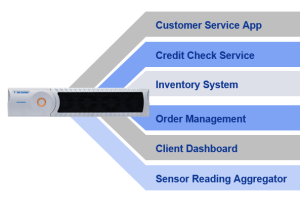If you have lots of applications that rely on messaging middleware to exchange information, you’re probably used to each one having its own discrete software-based message broker. When you add up all those brokers and the servers they run on, managing the combined infrastructure is probably a pretty time-consuming and frustrating task for your middleware team.

Each Solace appliance can meet the data movement needs of many applications thanks to support for virtualization.
Fortunately, the Solace message router’s support for virtualization can seriously simplify their lives and save your company lots of money. Each Solace appliance has really impressive messaging performance — up to 24 million messages a second, and 1.6 million messages a second with fully guaranteed delivery.
That’s a lot more throughput than most individual applications could ever need, but thanks to Solace’s support for virtualization you can take advantage of all that capacity to host dozens of applications on each HA pair of message routers. This can dramatically reduce the architectural and operational complexity of your system, and cut the TCO of your message infrastructure.
In this video I’ll show off the operational advantages of Solace’s support for virtual message brokers from two different points of view:
- First, from the viewpoint of a middleware global admin we’ll see how the Solace message router serves as a central point for managing and monitoring the messaging infrastructure that all of your applications share. You have full control to allocate resources to the virtual message brokers and update these resource restrictions and configuration on the fly as needs evolve. I also show how easy it is to roll out a new virtual messaging service for a new application team including providing them with scoped admin access so they can get the most out of their virtual message broker.
- Then I’ll look at Solace’s virtualization support from the perspective of the application team who’s been given access to their new virtual message broker. We’ll use their admin access to finish rolling out our JMS application and pass traffic. You’ll see how it takes less than 10 minutes for the global admin to roll out a virtual message broker and the application team to get their JMS service up and running.
Demonstration of Solace Message Router Virtualization Capabilities
Explore other posts from category: Products & Technology

 Mark Spielman
Mark Spielman
